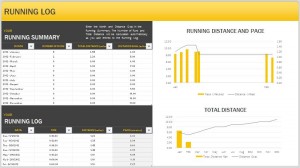24
May

Every serious runner needs to know how often, how far, and how fast they are running. Every runner needs to know these three things in order to achieve their goals, whether that is to merely finish a run or to qualify for the Boston Marathon. They also need to know these three components to avoid injury. Therefore, keeping a running log is all about balance, balancing progress and prevention.
How to Use the Running Log
- First, customize your free running log by imputing your distance goals in miles for each month. Be careful not to increase the mileage more than ten percent month to month. Increasing the mileage at a higher rate increases the risk of being sidelined by injury.
- Second, start logging your dates, times and mileage after each run. Excel will calculate your pace. Remember to keep the effort at a conversational level. Generally, it is better to run the distance than keep a time. Eventually, a well-trained runner will achieve both.
- Third, keep an eye on the running summary section of the log. This portion of the log will tabulate how many times you have run in a month. Be sure to rest between runs.
Tips on Using the Running Log
- First, celebrate your progress as you enter each run into the log. The log makes it easy to add notes about your accomplishments.
- Second, remember a running log is not just about progress, but prevention. Be sure to add a comment to the log on the date new shoes are put into service to avoid injuries caused by worn out shoes.
- Third, allow your log become a motivational tool to lace up your shoes and get moving. Add statements about why you choose to run or mark entries where you ran a personal record.
Runners, from beginning to advanced, need to keep track of their dates, times, and paces to complete their training goals and stay healthy. Use of the easy running log from can help them moderate the ups and downs of the active life.
Download: Running Log
X
Your free template will download in 5 seconds.
Check this out while you wait!
Check this out while you wait!
